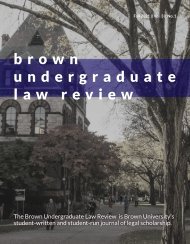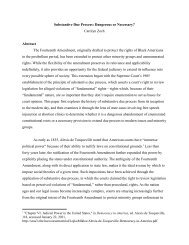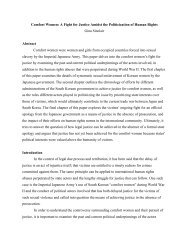Brown Undergraduate Law Review — Vol. 2 No. 2 (Spring 2021)
We are proud to present the Spring 2021 issue of the Brown Undergraduate Law Review. We hope that the works contained herein offer insight and inspiration to all who read them.
We are proud to present the Spring 2021 issue of the Brown Undergraduate Law Review. We hope that the works contained herein offer insight and inspiration to all who read them.
You also want an ePaper? Increase the reach of your titles
YUMPU automatically turns print PDFs into web optimized ePapers that Google loves.
Targeting Muslims and Civil Liberties Prevention:<br />
An Analysis of the Countering Violent Extremism Program?s First Amendment Violations<br />
from having influence in the American marketplace of<br />
ideas.<br />
Freedom of Speech: Supreme Court Precedent<br />
punishment of which have never been thought to raise any<br />
Constitutional problem. These include . . . ?fighting<br />
words?? those by which their very utterance inflict injury<br />
or tend to incite an immediate breach of the peace.? 33 Free<br />
Of the principal constitutional concerns with CVE is the<br />
way in which it seeks to restrict constitutionally-protected<br />
free speech. CVE seeks to prevent ?violent extremists and<br />
their supporters from inspiring, radicalizing, financing or<br />
recruiting individuals or groups in the United States to<br />
commit acts of violence.? 30 The key problem this<br />
definition poses is that it deems the support and inspiring<br />
of violence as a criminal act. This is in violation of<br />
precedent set by the Supreme Court in Brandenburg v.<br />
speech can only be limited when there is an imminent<br />
threat of violence. CVE programs, by and large, have<br />
failed to demonstrate that any of their programs target<br />
individuals or groups who have explicitly threatened<br />
violence or used ?fighting words? as defined by this<br />
Supreme Court decision. By nature of the unwarranted<br />
restrictions CVE programs put upon the freedom of<br />
expression of various Muslim communities, CVE is<br />
unconstitutional under Chaplinsky.<br />
Ohio (1969).<br />
The Court?s ruling in Cantwell v. Connecticut (1940) is<br />
Brandenburg dealt with the constitutionality of an Ohio<br />
criminal syndicalism law, which ?punishe[d] persons who<br />
?advocate or teach the duty, necessity, or propriety? of<br />
violence ?as a means of accomplishing industrial or<br />
political reform.?? 31 The Supreme Court ruled that ?a<br />
statute which fails to to draw this distinction [between<br />
mere abstract teaching and preparing a group to use<br />
also relevant in examining CVE programs? stifling of<br />
American Muslims? right to free religious speech. In<br />
Cantwell v. Connecticut? involving a Jehovah?s Witness<br />
proselytizer who was charged with inciting a ?breach of<br />
the peace?? the Supreme Court delineated what could be<br />
considered a ?breach of the peace.? The Court?s opinion<br />
explained in part that<br />
violence] impermissibly intrudes upon the freedoms<br />
guaranteed by the First and Fourteenth Amendments.? 32<br />
CVE explicitly states that its focus is on the ?marketplace<br />
When clear and present danger of riot, disorder,<br />
interference with traffic upon the public streets, or<br />
other immediate threat to public safety, peace, or order<br />
of ideas? and preventing people from accessing<br />
appears, the power of the State to prevent or punish is<br />
?extremist? and ?radical? thought. The decision in<br />
Brandenburg makes it clear that it is unconstitutional for a<br />
government program to target and criminalize even the<br />
teaching of and exposure to ?radicalizing theories,? let<br />
obvious. Equally obvious is it that a State may not<br />
unduly suppress free communication of views,<br />
religious or other, under the guise of conserving<br />
desirable conditions. 34<br />
alone religious teachings.<br />
The primary rationale offered for CVE programs is the<br />
In Chaplinsky v. New Hampshire (1941), the Supreme<br />
Court held that ?there are certain well-defined and<br />
protection of national security and public safety. However,<br />
CVE fails as a program to demonstrate how the Muslim<br />
narrowly limited classes of speech, the prevention and<br />
30. Executive Office of the President, Strategic Implementation Plan (2011), 1.<br />
31. Brandenburg v. Ohio, 395 U.S. 448 (1969).<br />
32. Ibid.<br />
33. Chaplinsky v. New Hampshire, 315 U.S. 571-572 (1942).<br />
34. Cantwell v. Connecticut, 310 U.S. 308 (1940).<br />
<strong>Brown</strong> <strong>Undergraduate</strong> <strong>Law</strong> <strong>Review</strong><br />
26










